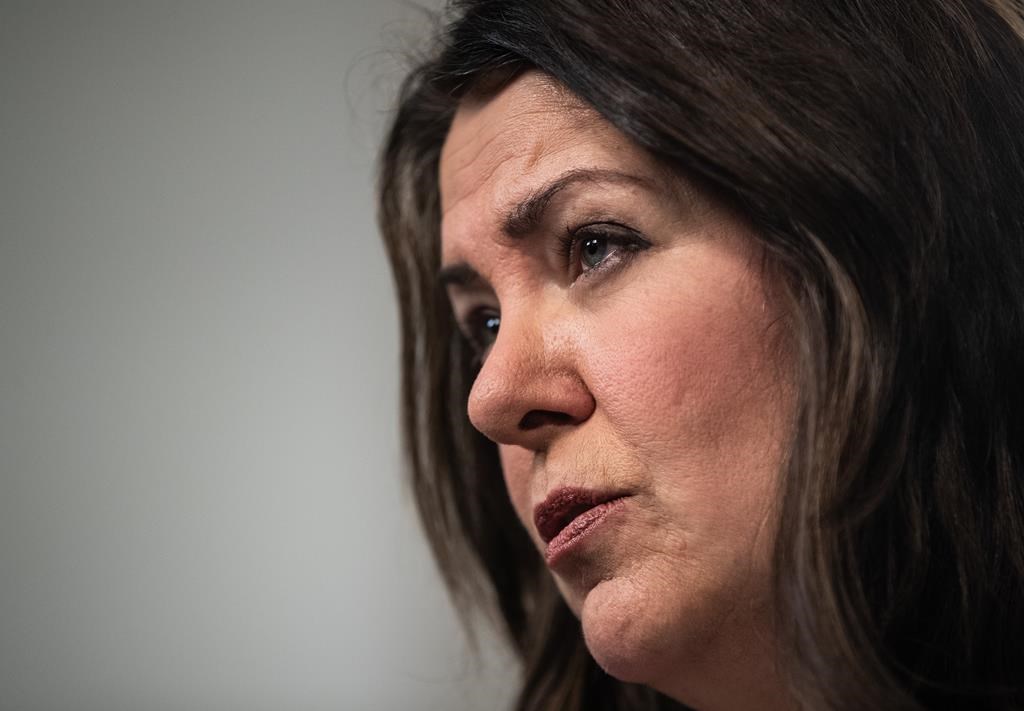Alberta sovereignty act on table in fight against feds 2035 net-zero goal
Posted Sep 28, 2023 5:59 pm.
Last Updated Sep 28, 2023 8:01 pm.
Premier Danielle Smith says Alberta is determined to fight Ottawa and its Clean Energy Regulations (CER), which could include a motion to use the sovereignty act.
In a news conference in Calgary Thursday, she made the statement while promoting an awareness campaign meant to “inform Canadians of Ottawa’s reckless and costly plan.”
She says the province would be prepared to use the act if the federal government “comes through with emissions caps that are unconstitutional.”
“We’re preparing a sovereignty act motion and I’m hoping we don’t have to use it. That’s why we’re at the table having these negotiations,” Smith told reporters Thursday.
“But we are going to defend our constitutional jurisdiction to make sure that we develop our oil and gas industry at our own pace and that we develop our electricity system so that it achieves the goal of reliability and affordability.”
In her speech prior to her mention of the Alberta Sovereignty Within a United Canada Act, she says “poorly conceived doesn’t begin to touch on their injustice” on Ottawa’s 2035 energy regulation plan.
“They are disastrously uninformed and totally disconnected from reality,” she said.
“If implemented, the proposed federal electricity regulations will stick Canadian families and businesses with unaffordable bills and provincial governments with crushing debt and the grid itself based on unreliable energy sources.”
Watch: Alberta reacts to Ottawa’s net-zero plans
She says the province doesn’t have the infrastructure and storage capacity for renewable energy to meet the goals of the CER.
“First …the cost of Canada’s electricity systems has been built up over decades, radically redesigning them in 12 years would cost Canadians at least $1 trillion and possibly as much as $1.7 trillion,” she explained. “Alberta would bear the largest cost of any province estimated at coming anywhere between $200 billion to more than $400 billion.”
“And those expenses would ultimately end up being passed on to you Albertans everyone, from single parents to nonprofits to small businesses.”
The federal government released draft regulations in early August that are meant to clean Canada’s electricity grid in an affordable way by 2035.
Alberta is proposing a 2050 net-zero energy grid, and Smith has a working group discussing the issue with federal counterparts.
The Sovereignty Act was passed by Smith’s government in the fall of 2022 as her signature legislation when she took over as premier.
Its aim is to give the province the power to reject federal rules and programs it deems to be unconstitutionally interfering in areas of provincial responsibility, such as energy development.
The act’s legal validity has not been tested in court.
Independent operator AESO shares concerns on CER
Earlier in a separate announcement Thursday, the president of the independent Alberta Electric System Operator (AESO), Michael Law, outlined a detailed report presenting numerous challenges in CER for the province, saying Alberta would face disproportionate risk compared to other provinces and bear disproportionate costs.
“Alberta is reliant on natural gas generation, both for baseload and to meet peak demand, and it enables reliability and balances the intermittency of other assets,” he said.
“The CER creates significant operational restrictions to Alberta’s flexible generation fleet that cannot easily be met with cost-effective decarbonize technologies presently available in Alberta.”
Approximately 72 per cent of electricity came from gas-fired resources in 2022, and 12 per cent from coal-fired resources. He says Alberta’s generation fleet stems primarily from the abundance of reserves in these areas.
Law says the CER doesn’t acknowledge what “Alberta has already achieved and the positive trajectory that we’re on.”
“Since 2005, the electricity emissions have fallen by more than 44 per cent from around 50 megatons to less than 30 megatons, and our projection so that the industry emissions will continue to fall to below less than 10 megatons in 2030,” he explained.
“These reductions are being achieved by the phase-out of coal-fired electricity, which will, as I said, be completed early next year, as well as through the effects of carbon pricing and the integration of renewables onto our system.”
Related Stories:
-
Alberta reacts to Ottawa’s net-zero plans
-
Federal government releases new draft regulations on clean electricity
-
Alberta needs ‘middle ground’ in renewable project development: experts
While he says the province’s electricity generation capacity has adapted more quickly than any other province in Canada, he says Alberta will not have sufficient resources to ensure reliability in 2035.
Law adds that Alberta can’t be the province to lead.
“First-of-its-kind technologies have a history of big cost overruns, technology challenges, etc. That is a concern that pace helps mitigate. We get to learn from other jurisdictions,” he said.
Awareness campaign being spread across Canada
Smith says the awareness campaign will include print, radio, television, social media ads, billboards, and bus wraps, which she says will highlight how the regulations will make it “more expensive for Canadians.”
“It’ll drive off investment in jobs, and it will threaten the reliability of our power grid and put it at risk,” she said.
“And as we all begin to feel the temperatures dip in the wind grow cooler, having just come off a summer with with heat waves, we are reminded that we live in a country of extremes. Our campaign urges everyone to contact their MPs and have their say so that Ottawa can hear how many people are deeply concerned.”
Related Stories:
-
Ottawa reveals conditions for allowing future fossil fuel subsidies
-
Poll suggests two-thirds of Albertans oppose pause on renewable energy approvals
Smith notes the province is “determined to reduce emissions.”
“Our province cut electricity emissions by 53 per cent between 2005 and 2021, and we’re enacting a plan to create a reliable and affordable carbon-neutral power grid by 2050,” she said. “The key words here are reliable and affordable. Anything else will lead to ruin for Canadian families, businesses and the economy.”
“We cannot afford to stay quiet on this.”
The podium Smith stood on had two banners that read “No one wants blackouts in -30,” and “No one wants to freeze in the dark.”
Federal minister wants to see AESO numbers
Meanwhile, Federal Environment Minister Steven Guilbeault challenged Smith’s comments and called on AESO, which runs the province’s power grid, to show the numbers and assumptions to back its claim that the 2035 net-zero timeline is unrealistic.
“Any claim that building a clean electricity grid in Alberta will lead to blackouts is misinformation, designed to inflame not inform,” said Guilbeault in a statement.
“We believe our goals are aligned and we are keen to engage constructively with the AESO and the Government of Alberta to make sure we get these details right. That’s one reason why we created the Alberta-Canada working group.”
Guilbeault said Canada does not want to be left behind as the United States and other G7 countries move toward clean electricity.
“This is a huge economic opportunity that we do not want to miss. That’s why industry and labour groups support it,” said Guilbeault.
“The draft regulations are designed with at least 12 years before they come into effect, giving time to attract investment and adjust decision-making. Because of the flexibilities we’ve built in, there is no cliff for natural gas plants as a result.”
Watch: Alberta premier says net zero power grid by 2035 is unachievable
The Opposition NDP echoes his statements, saying that the 2035 goal is the norm all around the world and that the province needs to ramp up work being done to meet that goal.
“The world is trying to figure this out while this government is thinking in the past. There are solutions, we’re trying to figure this out, so I want them to be taking these concrete steps and I want them to show up and negotiate,” said Nagwan Al-Guneid, Alberta NDP energy and climate critic for electricity, utilities and renewables.
She says the UCP is actively working against the objectives of the CER and failed to create legislation that would enable more grid storage and increase reliability.
“They’ve also shut down the renewables sector for seven months that was delivering more low-cost energy. Now, Danielle Smith is threatening to use the Sovereignty Act that will create more uncertainty and drive away investment,” Al-Guneid continued.
“While tweaks and more flexibility to the Canada Electricity Regulations are needed, launching another taxpayer-funded campaign based on misinformation and threatening to use the Sovereignty Act are not the answer. Instead, the provincial government must be at the table negotiating these changes and demanding a significant portion of the $40 billion the federal government is making available.”
-With files from Shilpa Downton and The Canadian Press










